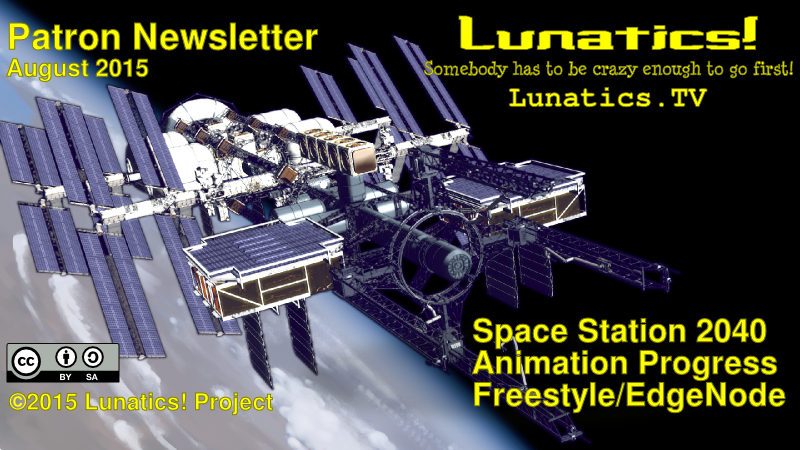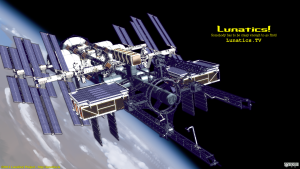Space Station Alpha in 2040
Depicting the right image of the future in Lunatics! is a delicate balance. We want to present a definitely-realizable, realistic future, that does not try to assume an implausible leap forward culturally, but which nevertheless shows real progress in space exploration and development. We also wanted to depict a pragmatic approach to space, which builds on what exists now, and extends it towards the future. We wanted it to reflect the logical extension of present-day ambitions of government and private interests in space, and we wanted to show it working out pretty well.
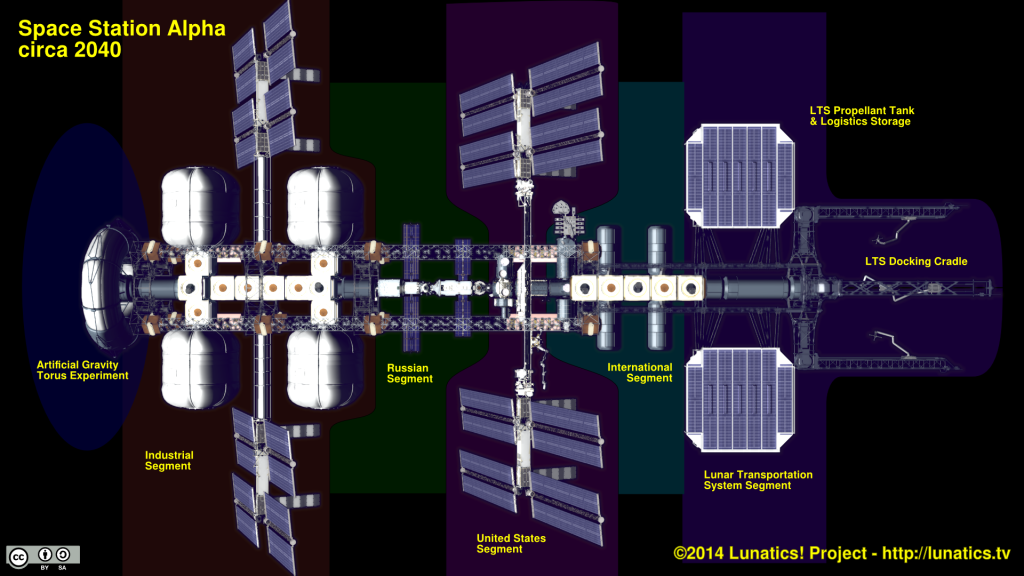
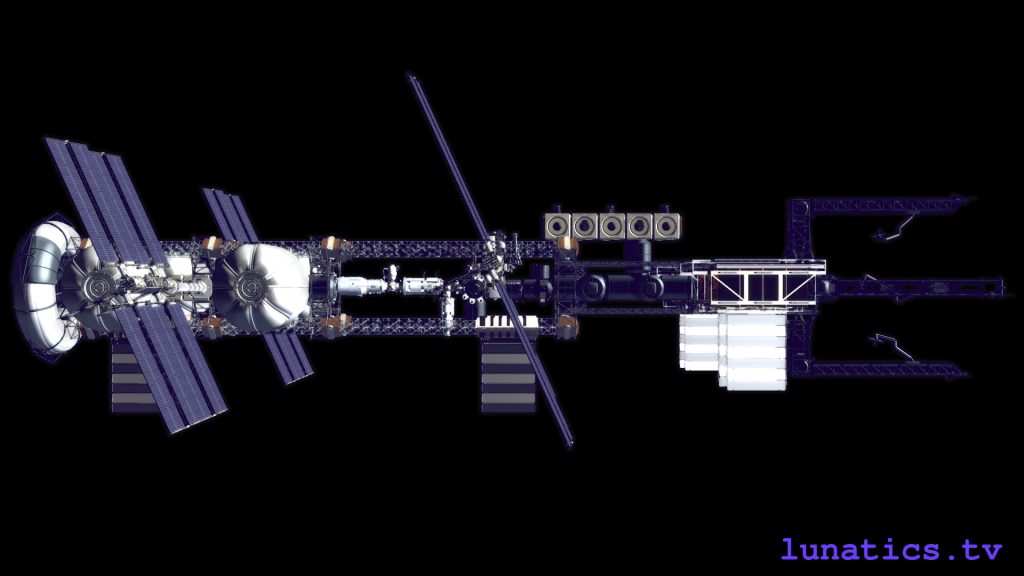
So we decided that the transportation hub space station needed for the LTS Moon Shuttle program in Lunatics would simply be an extension of the present-day International Space Station, following something like the “Alpha Town” privatization scheme imagined by some space visionaries as the path forward for ISS.
In this future scenario, when the ISS has served its primary research mission, it is gradually converted into a public facility along the lines of an airport (transportation hub) or an astronomical observatory (research facility), with a station management that allocates facilities to private and public interests. As with many things in our vision of the future in Lunatics, it’s a compromise between various interests. One that is shown to be working.
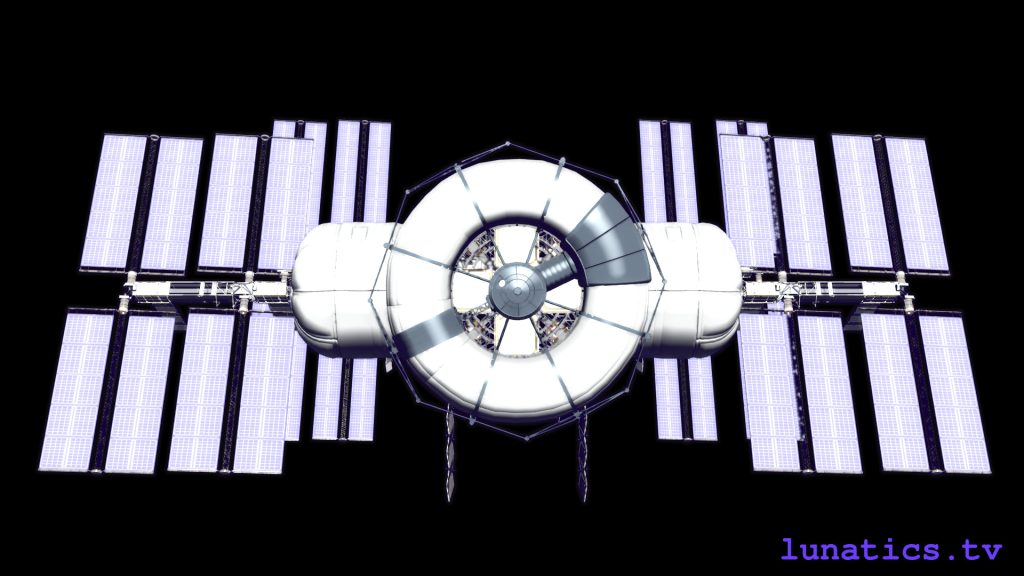
Private development on the new “Space Station Alpha” as it is known in this time, is primarily concentrated in a new segment connected to the present-day end of the Russian Segment, dominated by four large inflatable modules, which provide a huge interior volume, appropriate for the needs of enterprises ranging from a space hotel to a microgravity manufacturing facility. On the end of this segment, we have a new experimental artificial gravity torus which is currently spinning at simulated Martian gravity, in support of training for exploration projects for Mars.
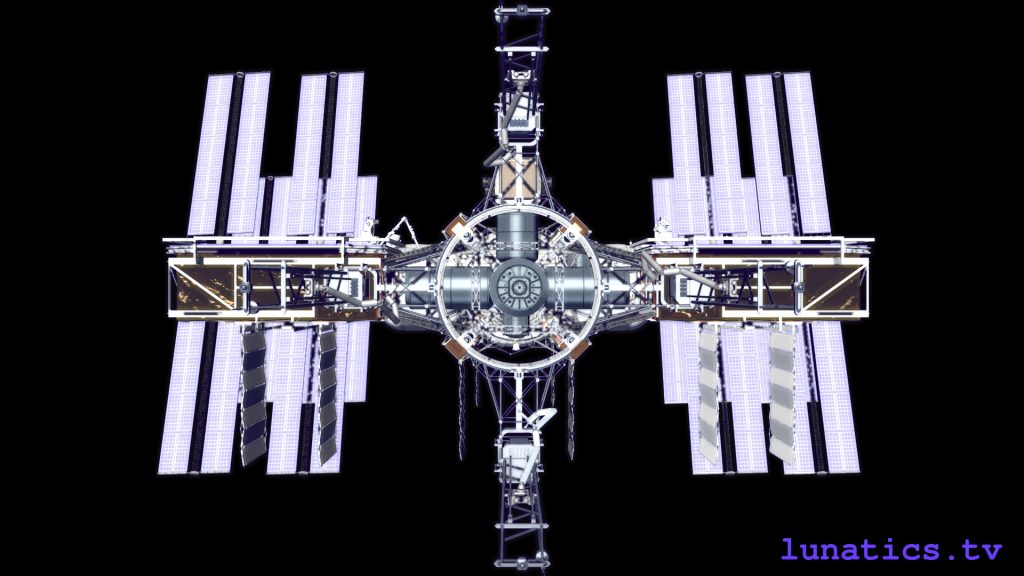
The opposite end of the station, past the present day “Harmony” module of the US/International Segment, is devoted primarily to acting as a transportation hub and logistical support for the Lunar Transportation System. This provides a single large dock for very large vehicles, like the LTS Moon Shuttles, large surface-to-orbit transports, and potentially for interplanetary vehicles. Above this is a docking system for parking up to eight small craft (like SpaceX’s Dragon, SNC’s Dream Chaser, Soyuz, and so on). We’re working on some small craft models to include in the exterior shots for the pilot, to make the station look busy.
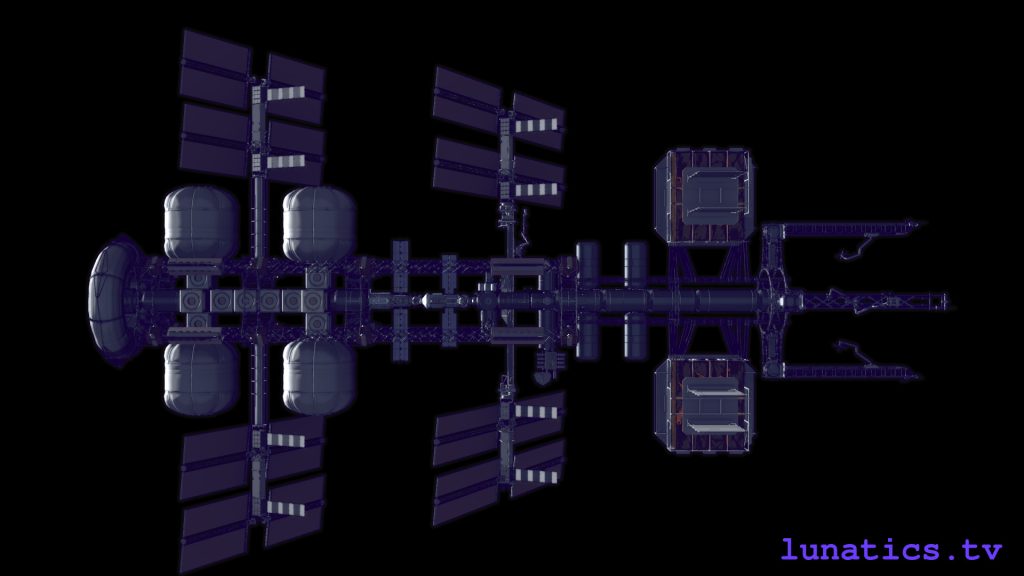
Naturally, all this expansion requires additional stiffening trusses, extra solar arrays for power supply, and additional thermal radiators to handle the waste heat.
Character Animation Progress
Our Fall 2015 team for character animation is shaping up
We now have two people planning to work on character animation, which we think will be sufficient (although there is probably room for more help). Our current plan is to animate
scene-by-scene (rather than shot-by-shot), with different animators focus on different characters. We haven’t quite ironed out all of the procedural details, but it looks like this should work.
Keneisha Perry has been doing a lot of animation testing. These are several work-in-progress animations, showing some of her work so-far, including all three types of animation we discussed last month (key-framed body animation, action-based animation, and lip-sync):
Animation tests by Keneisha Perry.
And this video is a closer look at the animation she’s developing for the train sequence, which is the first piece of dialog in “No Children in Space”:
Animation tests by Keneisha Perry.
We’re also being joined by another CSU graduate, Christina Backlund-Newton, specifically for work on character animation. Here’s a peak at the last production she worked on while a student at CSU:
S-Car-Go: A Chico State Animation Studio Production
Although her human character animation work might be more relevant to what we’re doing:
APCG 340 animation reel
Freestyle vs EdgeNode Test
This month, we tested an alternative ink rendering system called “Edge Node”
Freestyle is a pretty amazing package, but it’s also a real memory hog and very slow. In fact it uses so much memory, that it’s not uncommon to run out, sending the computer into a slow death by swapping. We have to use complex work-arounds to get around these problems with complex models (like the space station shown on this month’s cover).
So, I was intrigued to read that Bong Wee Kwong (better known online as “Light BWK”) had released a version of his “EdgeNode” package, which works entirely in the Blender compositor. Unlike Freestyle, EdgeNode works entirely with the bitmap renders produced by Blender’s internal rendering engine.
How it works is to analyze the “Z-Depth” and “Normals” output (which can be accessed directly from the Render Layer nodes in Blender’s node-based compositor). This means that details too small to see simply don’t contribute to the computations it needs to run, and in general, it is both much faster and much more consistent in speed than Freestyle.
But how good does it look? And how important is that speed-up to our total per-frame rendering time? Basically, there are three possibilities:
- EdgeNode does not meet our standards, and we should stick with Freestyle (only)
- EdgeNode beats Freestyle in every way, and so, despite being committed to Freestyle, we jump ship and convert to using EdgeNode
- EdgeNode and Freestyle have distinct use cases, and we can benefit from using both of them.
This month, I decided to find out which applies. I ran a series of tests on a single frame from the shot outside the Baikonur train station, and compared them very carefully.
Here’s the frame, rendered using Freestyle as currently set up in our source tree:
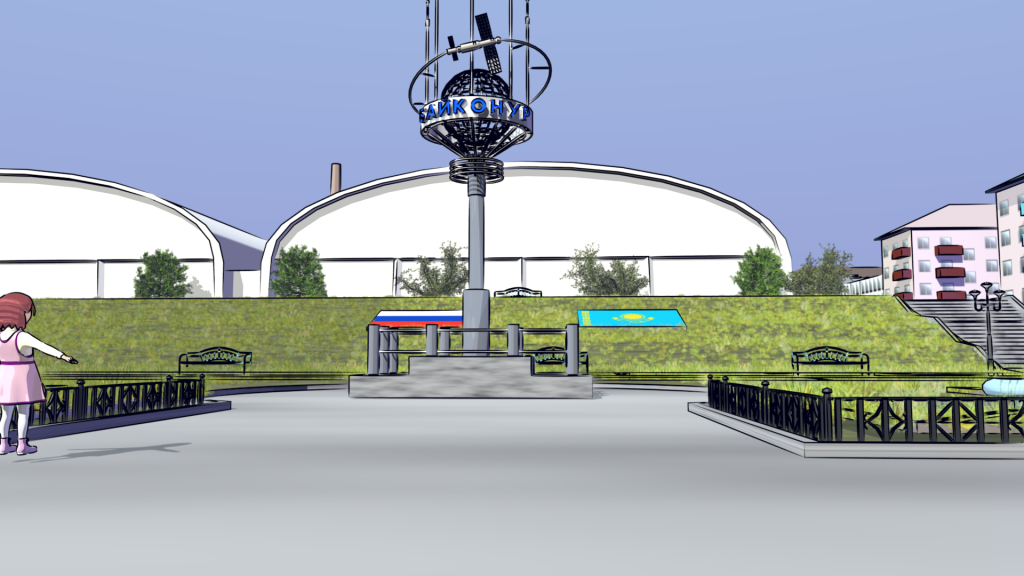
Now, let’s try to see if we can come up with a similar render using EdgeNode. There’s a lot of detail involved in how I did this. EdgeNode still has the same kind of problem with billboards that Freestyle does — namely that it doesn’t understand alpha transparency and tries to draw the outlines around the billboards. In both cases, the solution is to use a Render Layer with proxies to replace the billboards. A material-index technique worked to mask out the very-detailed trees in the background, where I didn’t want individual lines to be drawn.
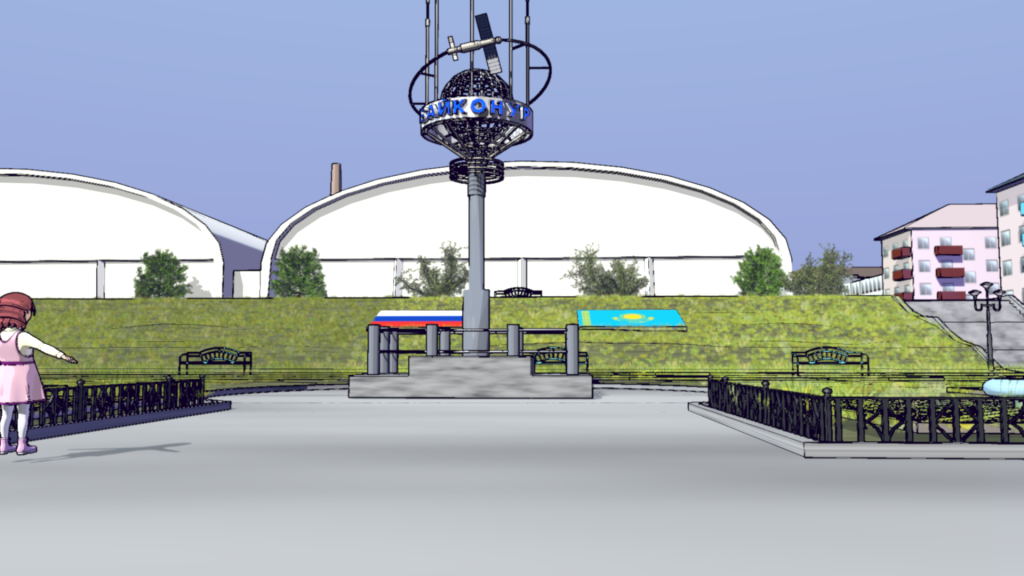
At first glance, these look pretty similar, though a few differences can be picked out here and there. Re-rendering each image with just the ink will make comparisons a little easier. First the Freestyle version:
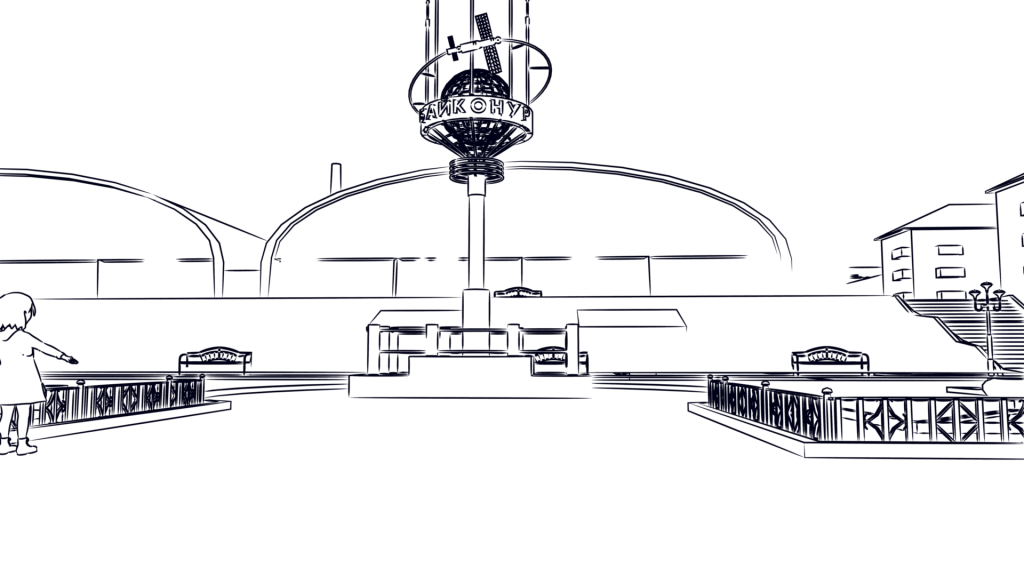
…and then the EdgeNode version:
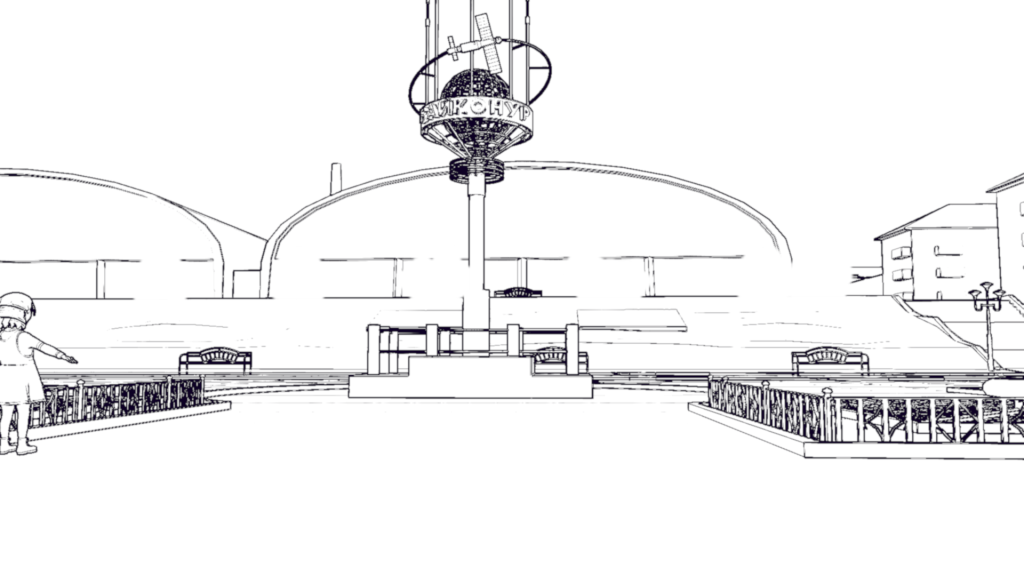
To make an even more detailed analysis, we can overlap the images and color-code them. This allows us to pick out specific strengths and weaknesses of each technique:
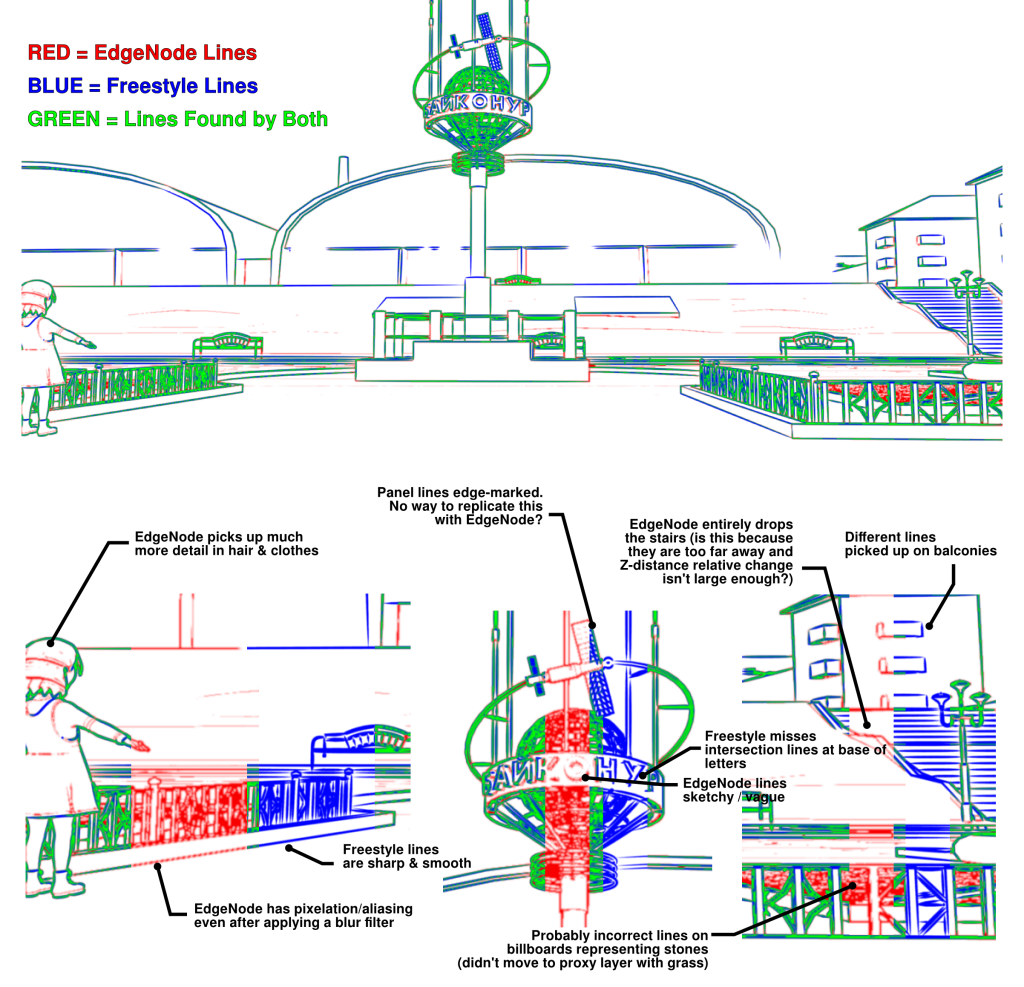
Clearly there are pros and cons to each one. My main assessment is that EdgeNode is mostly not worth the trouble in this shot. However, I decided to try out a combination of the two, which was intended to bring out the best of each system. Here’s the ink-only image:
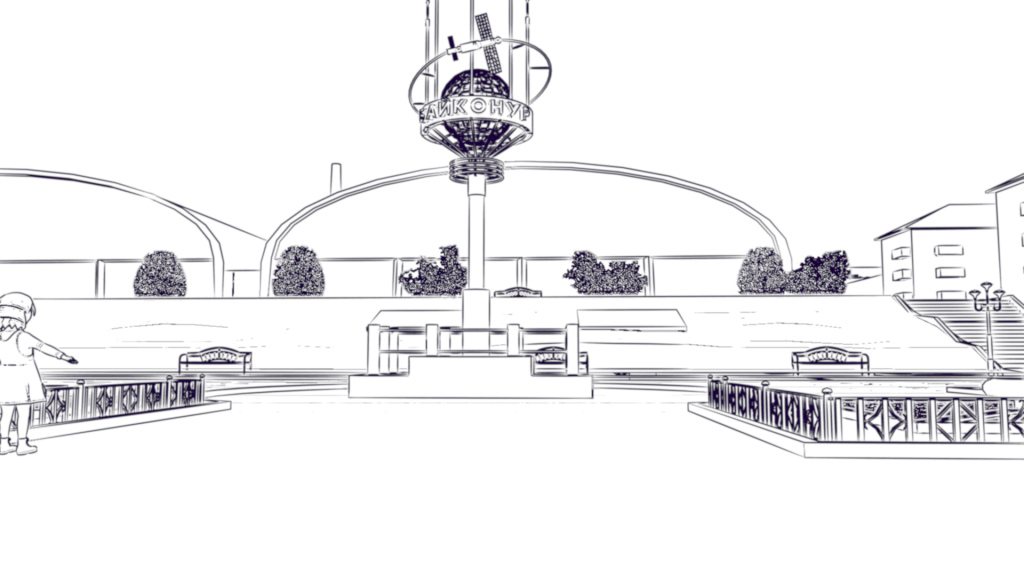
As you can see, I chose to let EdgeNode draw lines on the trees in the background — unlike Freestyle, it doesn’t get bogged down on this kind of detail. In most other places, I used a mask based on dilating and blurring the Freestyle lines to suppress EdgeNode lines in places where Freestyle was successful (because when Freestyle works, it generally produces a cleaner line). However, I thought that a scratchy line would be better than no line, and so where EdgeNode finds lines that Freestyle doesn’t, I let the EdgeNode lines show up.
And here is the resulting, compositing image, combining fill color with the ink:
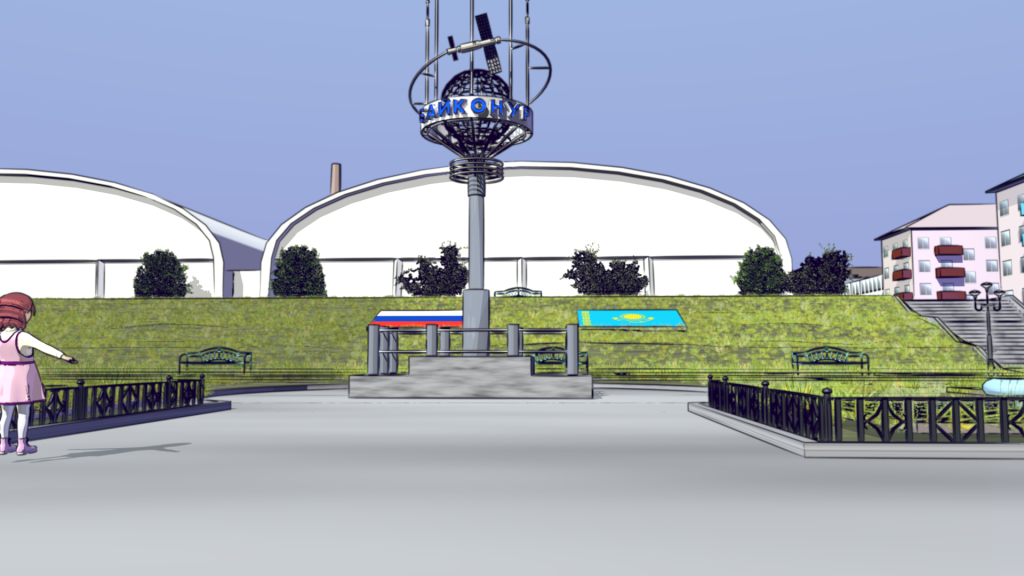
Here is the Blender compositor node system used to make this combination render:
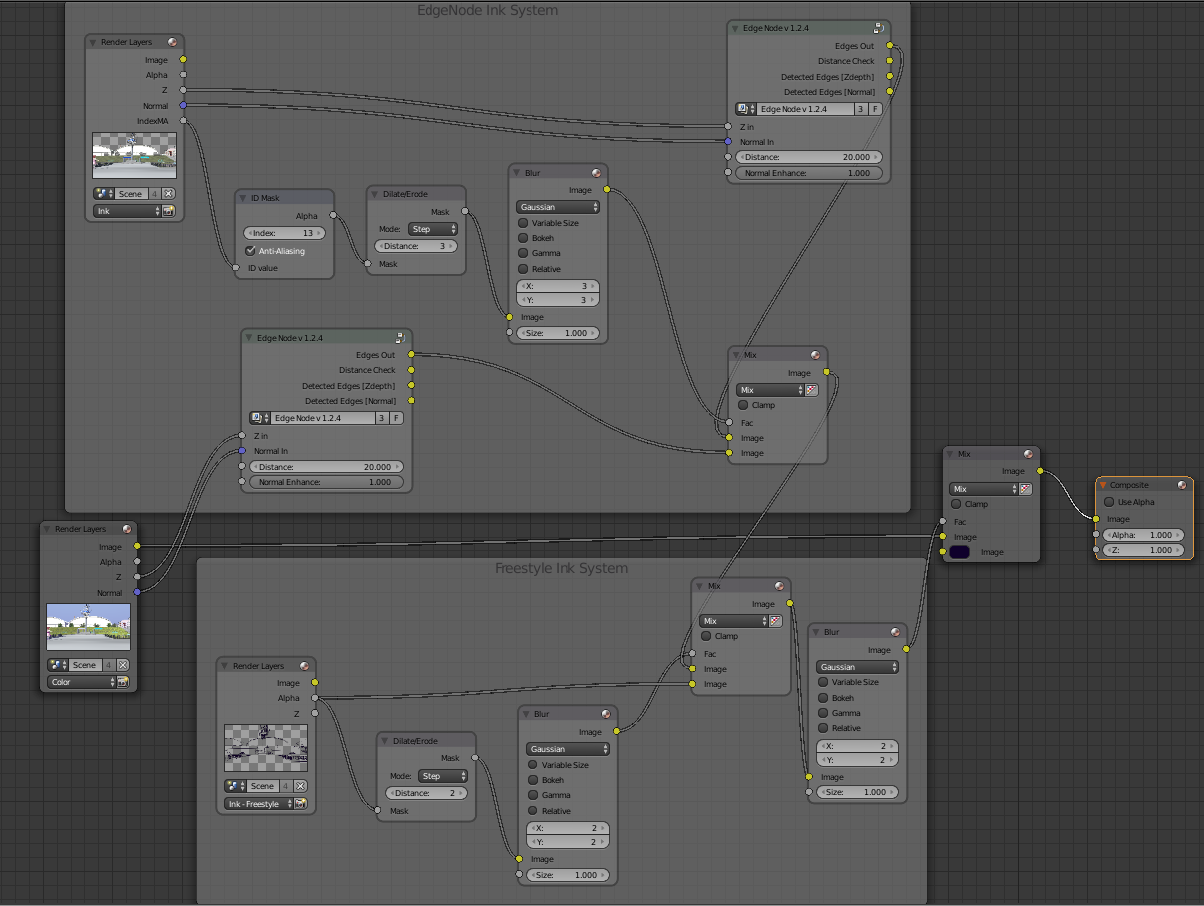
Conclusions
EdgeNode certainly has some interesting features, although I think there is enough
of a drop in quality and flexibility to continue using Freestyle for most purposes. However,
I can see some specific use-cases which might make EdgeNode worth using as an extra tool:
- For pre-visualization. Freestyle is really slow to render, and doing an EdgeNode render may be better for comparisons than using an inkless render.
- Fixing pathological models. EdgeNode can simplify the preparation process if Freestyle isn’t really necessary. For example, I used EdgeNode to generate the Space Station renders in this Newsletter, since it’s a very complex model which would require a lot of extra work with ink proxy objects to render correctly with Freestyle.
- Detail lines for objects too time-consuming for Freestyle, like the trees in the Train Station render — although we should also consider whether these look better without lines.
- To fill in the missing lines when Freestyle makes it too difficult — such as models with a lot of missing intersection lines.
I think we’ll probably find a variety of niche cases where EdgeNode is the right way to handle certain shots or elements of shots that can be composited. This will, of course, have to be weighed against the extra compositing required. But in this case, the render time added by EdgeNode is negligible, while Freestyle’s cost is very significant.
Then and Now: A Side-by-Side Comparison
We recently found the animatic version of the opening sequence for “No Children in Space” and decided to make a video comparing it with our current, nearly-final version. It’s interesting both for what has changed and what has stayed the same:
Side-by-Side Comparison of Storyboard Animatic to Current Version of opening for “No Children in Space”
Other News
- Internships
- Our three California State University Media Interns have all successfully completed their maximum credit requirements for their internships this Summer, which has been a good experience for all involved. We now provide the only remote/telecommute option for CSU Media Internship Program students, and will be offering additional internship positions this Fall. At least two of the students will be continuing this Fall.
- Animation workflow and team established
- This means we’re back on track for releasing episodes. I am not certain yet of the timescale we can do this on, but I’m pretty confident now that we’ll be making releases before the year is out.
- Rendering Cluster
- We’re costing out the current cost of the dedicated render cluster we have been talking about. There are a couple of funding options that we’re looking into, which might come through for us, but we can’t say much more than that yet. There is hope, though.
- One Year of Newsletters
- This the 12th monthly Patron Newsletter, so this is the first anniversary for this Newsletter series. We hope you have enjoyed them! We’re considering offering either individual back issues or the entire year in one volume in a downloadable e-book format (probably EPUB or PDF). This will probably be offered on a “pay what you like” basis as a possible way to raise some project funds.
Until Next Month!
